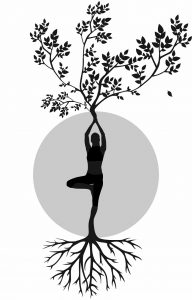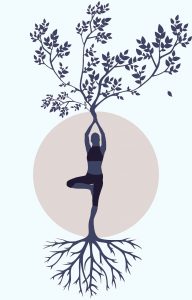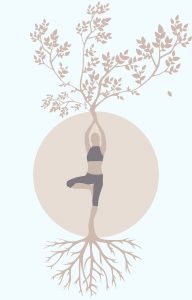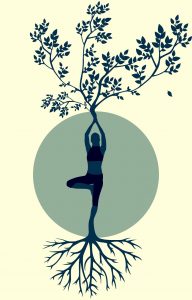There is a lot of misunderstanding and contradictory knowledge that can be really confusing when it comes to wanting to correct your posture.
These 7 principles can act as a basic underpinning and supportive context in how to implement positive change in your posture.
These are tips that can be useful if you are concerned about how you sit at work or if you are an advanced yoga practitioner wanting to improve your yoga poses.
At the end you’ll find a simple somatic mindfulness exercise to help you put into practice the 7 posture principles.


Posture is never fixed. It’s an alive process.
If you think about it; your body is never still. The breath is in constant motion. As you inhale your lungs expand, the diaphragm descends and your spine gently extends. Your body won’t feel free and open if you think of posture as being a fixed and unmoving position. This won’t help your body to be healthy and supple. Good posture needs a flow of energy. A healthy stance is where there is potential for movement.

Posture is Functional.
Posture serves a purpose. Good posture lets your body be aware of its surroundings. How you sit, stand and walk is how your body knows where it is in space.
If you get lost in the middle of a new city, you get out the map and figure out where you are. You orient yourself. Good posture is when the body is well oriented.
Good posture is the body making tiny micro-movements, to help you know where you are in that moment. Poor posture leads to a lack of presence; our relationship with our environment is subtly compromised.


Gravity is your friend.
The primary way that the body orients itself is through establishing a relationship with gravity. Where is the ground, where is my weight? The reason we rock a baby is to help it feel calm. It feels relaxed when it knows where the ground is. The rocking motion helps it fall into itself, it gives the baby its first feeling of ‘I am here’. So feeling your weight, knowing how to earth your body, is an essential quality of good posture and a calm presence.
When we bring attention to the soles of our feet and let them feel the connection through the skin to the ground this has an enormously calming affect on our nervous system.

Good posture includes your senses.
Another way that your body orients itself is through your senses. Your sight and hearing and sense of smell actually play a part in your posture. Your eyes and ears open upon the field of vision and sound. In other words your senses open you into the space around you. When we get depressed, tired and fed up we tend to limit the way our body opens into space. We are less aware of the space extending all around us. This then gets reflected in our posture, we stoop, our gaze lowers we contract and eventually our whole system becomes compressed. It is our senses that can help us open into space and orient us.
Just by bringing your attention to the wind or sun gently touching your face, by taking the
time to notice the tree tops, your body starts to open and lengthen as you feel the space around you growing in your awareness.

Compression is the enemy of good posture.
When the body gets stressed, through trauma, injury and long term bad habits it gets compressed. Compression comes about when we loose the natural relationship with gravity and space. Tension and stress pull us out of these fundamental relationships. This creates a strain on our tissue. The result is a defensive holding pattern.
Wellness and well being in our body starts to appear when we give the body space. We open and decompress the entire system.

Your ‘body image’ is not your body.
 Your ‘body image’ is the picture in your head of how you think your body looks.
Your ‘body image’ is the picture in your head of how you think your body looks.
‘Body image’ is nearly always negative. ‘My hips are too wide’, ‘my chest is too flat’, ‘my pecs should be bigger’. All these statements that we say to ourselves, create an image of what we THINK we look like. Often the image we hold is in fact distorted, full of self judgement and sadly often shame filled.
The shift towards health happens as you replace your ‘body image’ with the ‘felt sense’ of your body.
Your ‘felt sense’ is the sensory experience that you have of your body. The very sensations that you feel as you get in touch with your body moment to moment.
Getting in touch with your ‘felt sense’ allows you to feel how and where your body is, at this actual moment and can update your ‘body image’ and help it be more real.

Curiosity and exploration always deliver positive results.
Good posture happens in a complex web of relationships through the entire soft tissue of your body. Ideally you want to develop an integrated approach to your body and your posture. The ‘body image ‘ model leads to the ‘fix it’ approach . It makes us feel our body is a problem that needs fixing. The ‘felt sense’ model encourages us to be present to our body just as it is. We then start to explore our sensations. Through this natural curiosity the body learns to orient itself.
The body starts to heal itself when we give it attention.
 The exercise below is designed to give the experience of orienting yourself and allow you to get in touch with your ‘felt sense’. You can take anything from 5 to 20 minutes to do this simple somatic meditation. Make sure you won’t be disturbed, so you can really be attentive and not be distracted. You’ll need a flat bottomed chair or stool. Take time to get comfy first. You will need your pelvis, when sitting, to be higher than your knees. If you have very tight hips and/or a lower back issue have the seat higher from the ground, use cushions or a yoga black to add height. Ideally you will be barefoot and wearing comfortable clothes, tight jeans or tight skirts can be tricky. I’d recommend reading the exercise once, then reading it while going through the instructions in your body then closing your eyes and doing it from memory.
The exercise below is designed to give the experience of orienting yourself and allow you to get in touch with your ‘felt sense’. You can take anything from 5 to 20 minutes to do this simple somatic meditation. Make sure you won’t be disturbed, so you can really be attentive and not be distracted. You’ll need a flat bottomed chair or stool. Take time to get comfy first. You will need your pelvis, when sitting, to be higher than your knees. If you have very tight hips and/or a lower back issue have the seat higher from the ground, use cushions or a yoga black to add height. Ideally you will be barefoot and wearing comfortable clothes, tight jeans or tight skirts can be tricky. I’d recommend reading the exercise once, then reading it while going through the instructions in your body then closing your eyes and doing it from memory.
 Sit on the edge of your seat, so your back is not touching the back of the chair. Bring your thighs parallel so the knees are pointing forward. Ideally be barefoot. Do this part of the exercise with your eyes closed, to encourage proprioception. Take a moment now to feel your feet on the floor, how they receive the weight of your lower leg. Become aware of your connection to the ground as the soles of your feet soften and open. Notice how you can feel the ground coming up to meet your foot. These sensations allow your body to feel supported. Exhale deeply and feel your weight falling.
Sit on the edge of your seat, so your back is not touching the back of the chair. Bring your thighs parallel so the knees are pointing forward. Ideally be barefoot. Do this part of the exercise with your eyes closed, to encourage proprioception. Take a moment now to feel your feet on the floor, how they receive the weight of your lower leg. Become aware of your connection to the ground as the soles of your feet soften and open. Notice how you can feel the ground coming up to meet your foot. These sensations allow your body to feel supported. Exhale deeply and feel your weight falling.
 Then bring your attention to your sitting bones. You may want to move the flesh of your buttocks to the side so that you can feel the bones clearly. Do a very small micro movement to shift your weight from the back to the front of the sitting bones. Repeat this and notice how it feels in your pelvic floor . Come to a relaxed position so you are resting just on the front of your sitting bones. If you imagine your pelvis as bowl of water the bowl would be slightly tilted forward so the water gently runs out of the front of the bowl towards your feet. Notice how this helps the pelvic floor feel alive. Deeply exhale so the weight of your upper body can relax over the pelvis. Let tension fall away with every exhale and allow your body to feel its natural relationship with gravity. Feel your body supported by your feet and sitting bones. Relax.
Then bring your attention to your sitting bones. You may want to move the flesh of your buttocks to the side so that you can feel the bones clearly. Do a very small micro movement to shift your weight from the back to the front of the sitting bones. Repeat this and notice how it feels in your pelvic floor . Come to a relaxed position so you are resting just on the front of your sitting bones. If you imagine your pelvis as bowl of water the bowl would be slightly tilted forward so the water gently runs out of the front of the bowl towards your feet. Notice how this helps the pelvic floor feel alive. Deeply exhale so the weight of your upper body can relax over the pelvis. Let tension fall away with every exhale and allow your body to feel its natural relationship with gravity. Feel your body supported by your feet and sitting bones. Relax.
 Next bring your attention to the space around you. Do this second part of the exercise with your eyes open to encourage an orientation in space. Notice your field of vision opening to a distant horizon. Inhale and allow the intake of breath to open you into the world. Look at the objects near and far away, and notice the space between you and them. Feel the space. As you look out at the world become aware of your back and that there is an echo of the space in front of you reflected behind you. Your ears are listening to far away sounds. You notice how the sounds appear and disappear in a field of silence and space. The top of your head aware of the stars way beyond. Let the spatial field open with your senses and in breath, as far as you can.
Next bring your attention to the space around you. Do this second part of the exercise with your eyes open to encourage an orientation in space. Notice your field of vision opening to a distant horizon. Inhale and allow the intake of breath to open you into the world. Look at the objects near and far away, and notice the space between you and them. Feel the space. As you look out at the world become aware of your back and that there is an echo of the space in front of you reflected behind you. Your ears are listening to far away sounds. You notice how the sounds appear and disappear in a field of silence and space. The top of your head aware of the stars way beyond. Let the spatial field open with your senses and in breath, as far as you can.
 Notice the subtle micro movements as you shift your attention from feeling supported by gravity, and noticing your feet and pelvis and then opening your senses to the space around you. Feel the aliveness as your body orients in space and gravity and allow for subtle/micro shifts in your body position. Allow every cell to respond to the simple shifts in attention as you gently notice your relationship with gravity, and the limitless field of space.
Notice the subtle micro movements as you shift your attention from feeling supported by gravity, and noticing your feet and pelvis and then opening your senses to the space around you. Feel the aliveness as your body orients in space and gravity and allow for subtle/micro shifts in your body position. Allow every cell to respond to the simple shifts in attention as you gently notice your relationship with gravity, and the limitless field of space.
 Aidan Treays is a certified practitioner of Rolfing® Structural Integration. His background is in Dance and theatre arts. He practices at The Light Centre Belgravia and Monument and ad hoc sessions at Moorgate. He has a home practice in Blackheath SE London. Please feel free to call for support or advice or for a free postural analysis if you are thinking of embarking on the ten session Rolfing® process.
Aidan Treays is a certified practitioner of Rolfing® Structural Integration. His background is in Dance and theatre arts. He practices at The Light Centre Belgravia and Monument and ad hoc sessions at Moorgate. He has a home practice in Blackheath SE London. Please feel free to call for support or advice or for a free postural analysis if you are thinking of embarking on the ten session Rolfing® process.

